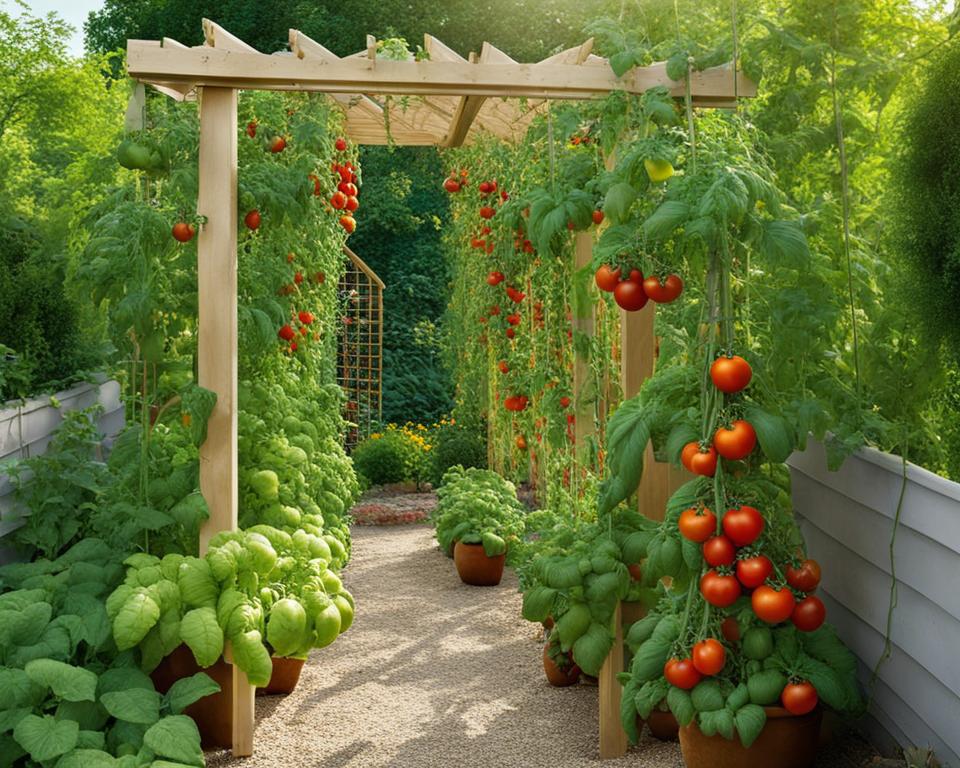Hello there, fellow gardening enthusiasts! Today, I’m excited to share with you my guide on vertical gardening systems for tomatoes. Whether you’re a seasoned gardener or a beginner, vertical gardening can be an excellent way to grow delicious tomatoes right at home. With the right techniques and systems, you can maximize your space, get creative with your garden design, and enjoy a bountiful harvest of juicy, ripe tomatoes.
In this article, I’ll be diving into the world of vertical gardening for tomatoes. From the benefits of vertical gardening to selecting the right tomato varieties, planting and caring for your tomato plants, and dealing with pests and diseases, I’ll guide you through every step of the process. Get ready to elevate your gardening game and grow some of the tastiest tomatoes you’ve ever had!
Key Takeaways:
- Vertical gardening systems are a great way to grow tomatoes at home.
- Selecting the right system and tomato varieties is crucial for success.
- Proper planting, caring, and nutrient management are key for healthy tomato growth.
- Pruning and training techniques can maximize productivity and prevent disease.
- Pests and diseases can pose challenges, but with the right knowledge, you can tackle them like a pro.
Why Vertical Gardening is Perfect for Tomatoes
When it comes to growing tomatoes, vertical gardening systems offer a range of benefits. As a tomato enthusiast, I am always on the lookout for ways to maximize my space and increase yields. By using tomato trellis systems and exploring creative vertical tomato garden ideas, you can do just that and more!
Tomato Trellis Systems
One of the primary advantages of using vertical gardening systems for tomatoes is the ability to use tomato trellis systems. These trellises allow you to grow your tomatoes vertically, saving space and preventing overcrowding.
There are various types of tomato trellis systems to choose from, including:
| Type of Tomato Trellis System | Description |
|---|---|
| Staking | Uses a single stake to support the tomato plant. |
| Caging | Uses a cage structure to support the tomato plant. |
| Stringing | Uses strings to tie up the tomato plant, providing support as it grows. |
Whatever the type of trellis you choose, ensure that it is sturdy and able to support the weight of your tomato plants as they grow and produce fruit.
Vertical Tomato Garden Ideas
Aside from tomato trellis systems, there are numerous creative vertical tomato garden ideas to explore. From using recycled materials to designing custom structures, there is no limit to what you can create.
Here are some vertical tomato garden ideas to get you started:
- Use a pallet to create a vertical garden.
- Set up a series of stacked containers.
- Hang pots from a fence or wall.
- Create a custom trellis system using bamboo poles.
Whichever vertical tomato garden idea you choose, make sure it is both secure and aesthetically pleasing.
Now that you know the benefits of using vertical gardening systems for tomatoes, it’s time to choose the right system. In the next section, I will guide you through the process of selecting the best vertical gardening system for your needs.
Choosing the Right Vertical Gardening System
When it comes to vertical gardening systems for tomatoes, selecting the right one is essential for optimal growth and successful yield. Here are some of the best options to consider:
Tomato Planters for Vertical Gardening
Tomato planters are excellent for small spaces and balconies. They come in various sizes and designs, from hanging baskets to wall-mounted planters. These planters allow you to grow tomatoes vertically while ensuring proper drainage and adequate soil.
Vertical Hydroponic Tomato Systems
Hydroponic systems are becoming increasingly popular for vertical gardening. These systems use a water-based nutrient solution instead of soil, which allows for more efficient nutrient absorption, resulting in robust plant growth. Vertical hydroponic systems have a small footprint, making them ideal for urban spaces.
| Advantages of Vertical Hydroponic Systems: | Disadvantages of Vertical Hydroponic Systems: |
|---|---|
|
|
Best Vertical Gardening System for Tomatoes
The best vertical gardening system for tomatoes depends on your space, budget, and the number of plants you want to grow. There are various systems available, such as trellises, towers, and cages, all designed to help support your tomato plants vertically. Consider your specific needs before selecting the right one for you.
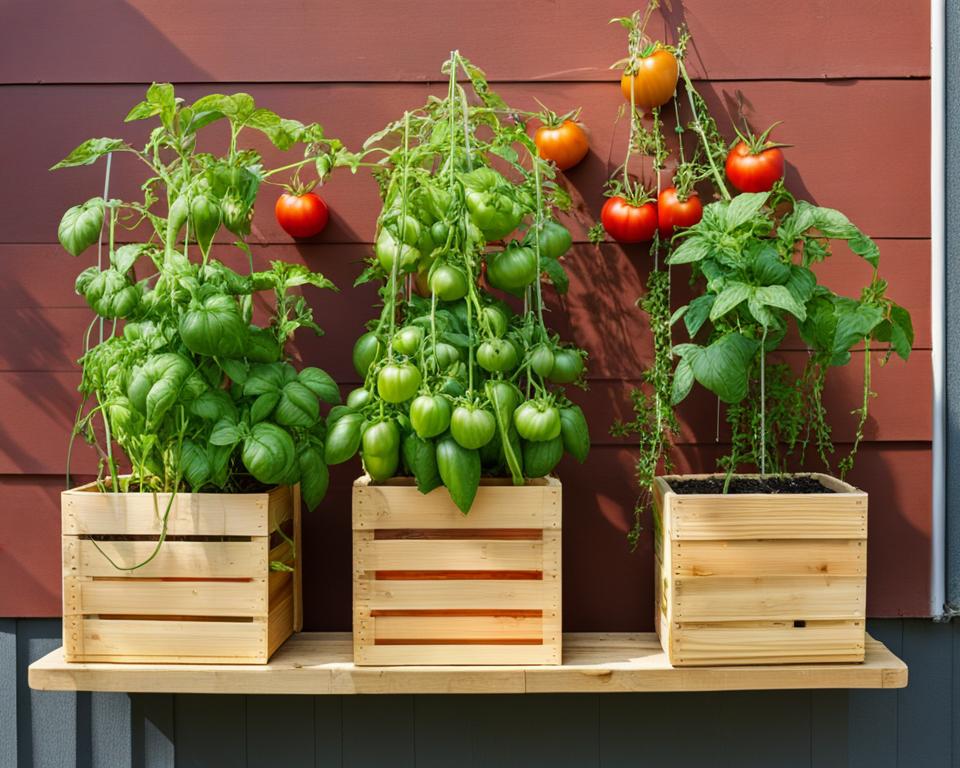
Whichever system you choose, make sure it is strong enough to support the weight of your tomato plants. Tomatoes can become heavy as they grow, and weak support systems can damage or break, leading to stunted growth or plant death.
By selecting the right vertical gardening system, you can ensure a bountiful harvest of delicious tomatoes right in your backyard.
Understanding the Basics of Vertical Tomato Gardening
Vertical tomato gardening can seem daunting, but with the right techniques, you can transform any space into a thriving tomato garden. Before you get started, there are a few key elements you must understand to ensure success.
Choosing the Right Tomato Plant
When selecting a tomato plant for your vertical garden, it’s essential to choose one that is well-suited for vertical growth. Determinate varieties are ideal for small vertical gardens, while indeterminate varieties are better suited for larger systems. Some popular tomato varieties for vertical gardening include:
- Roma Tomatoes
- Cherry Tomatoes
- Beefsteak Tomatoes
Keep in mind that different tomato varieties require different care and maintenance, so be sure to choose the one that best fits your needs.
Supporting Your Tomato Plants
Supporting your tomato plants is crucial for successful vertical gardening. There are several support systems to choose from, including trellises, stakes, cages, and more. The best support system will depend on the size and growth habits of your tomato plant.
Tomato trellises are an excellent choice for vertical gardening, as they allow for easy access to your tomatoes and take up minimal space. To build a tomato trellis, simply install stakes into the soil and attach string or wire between them for the tomato vines to climb.
Staking is another popular method of supporting tomato plants. To stake a tomato plant, insert a stake into the soil next to the plant and secure it with ties or clips. Then, gently tie the plant to the stake as it grows.
Providing the Right Growing Conditions
To ensure optimal growth, tomato plants require proper lighting, soil conditions, and moisture levels. Place your vertical garden in a location that receives at least six hours of direct sunlight per day, use nutrient-rich soil, and maintain consistent moisture levels by watering regularly.
It’s also essential to keep an eye on the temperature and humidity levels in your vertical garden. Tomatoes thrive in temperatures between 70-80°F and with humidity levels between 40-70%. If the temperature or humidity levels are too high or too low, it can affect the growth of your tomato plants.
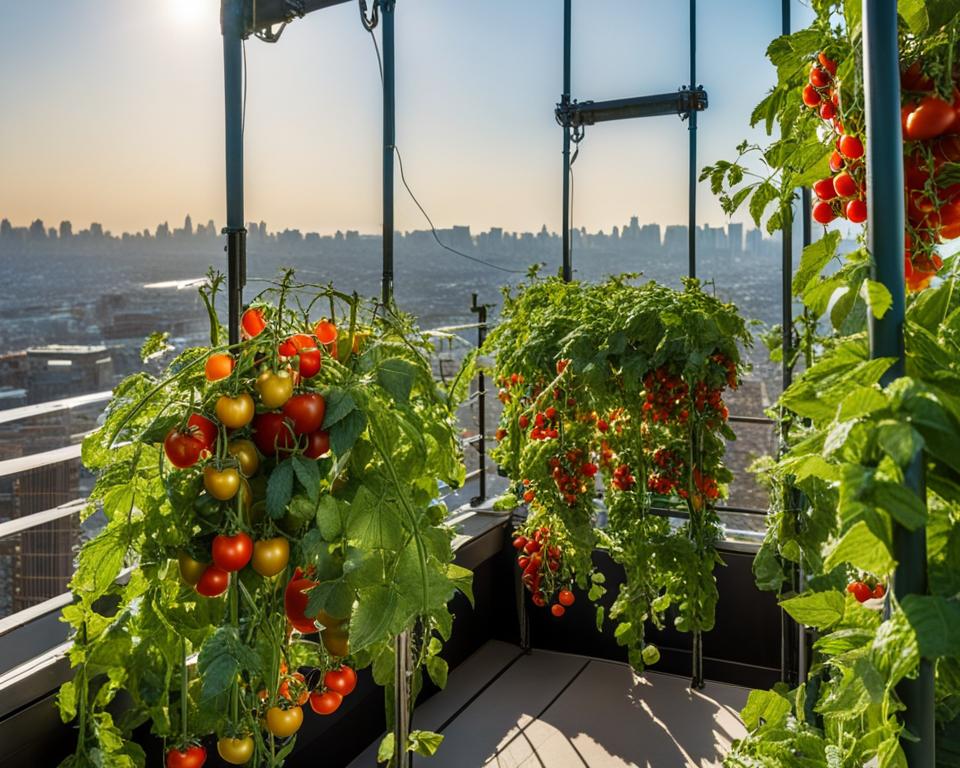
Tip: To maximize your tomato harvest, consider planting basil or marigolds alongside your tomato plants. These companion plants can help deter pests and improve the overall health of your garden.
By understanding the basics of vertical tomato gardening, you can set yourself up for success and enjoy a bountiful harvest of delicious tomatoes. Follow these tips to ensure your tomato plants thrive in your vertical garden.
Preparing Your Vertical Garden for Tomatoes
Before planting your tomatoes in a vertical gardening system, it’s essential to prepare the space properly. Here are the necessary steps to ensure your plants thrive:
Choose the Right Tomato Tower for Vertical Gardening
When selecting a tomato tower for vertical gardening, consider the size and shape of your garden. A sturdy, well-anchored tower is essential for supporting your plants as they grow. Plus, it maximizes vertical space and allows for better air circulation.
Here are some popular options:
| Tower Type | Pros | Cons |
|---|---|---|
| Steel Cage | Durable | Can be expensive |
| Bamboo Pole | Environmentally friendly | May need reinforcement |
| Wire Trellis | Easy to install | May not be sturdy enough |
Choose the tower that best suits your needs and complements your garden.
Optimize Your Space for Vertical Growth
Vertical gardening systems for tomatoes come in different shapes and sizes, so it’s crucial to optimize your space. Here are some tips for maximizing your vertical garden’s potential:
- Plant taller plants at the bottom and shorter plants at the top to ensure everyone gets enough light.
- Arrange your plants in a staggered pattern to allow each one to get ample sunlight.
- Place your vertical garden in a sunny location to encourage healthy growth.
By following these tips, you can ensure that your vertical tomato garden is set up for success.
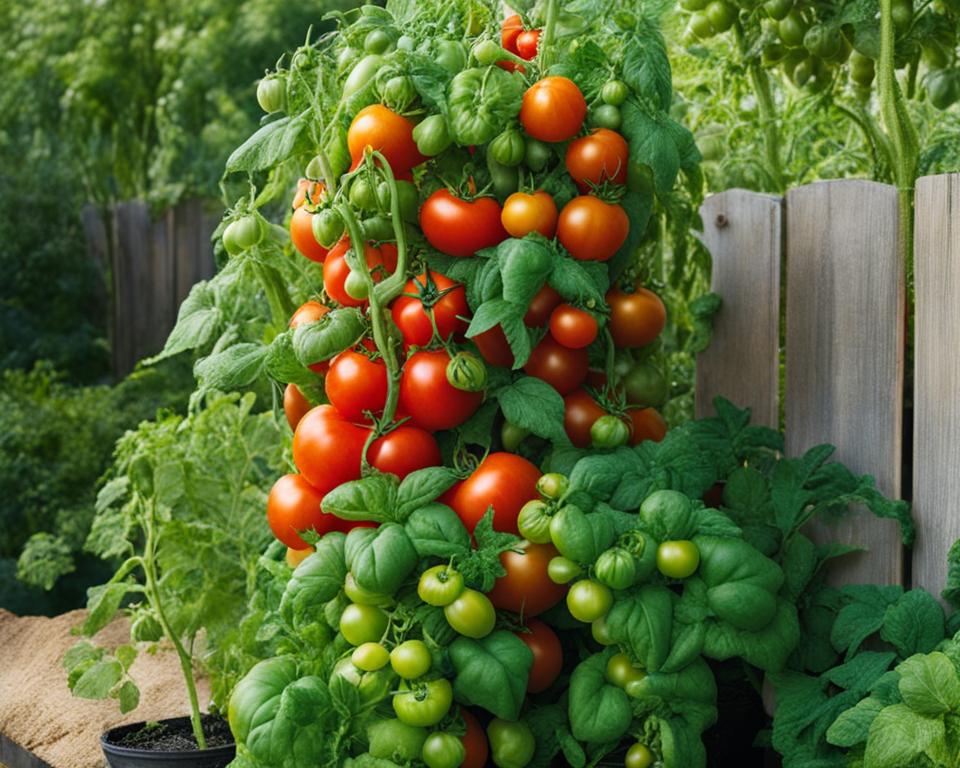
Remember to carefully plan your vertical garden and select the appropriate tower for your needs. With the right preparation, your tomatoes will be thriving in no time!
Selecting the Right Tomato Varieties for Vertical Gardening
When it comes to vertical gardening systems for tomatoes, selecting the right tomato varieties is crucial for a successful harvest. Certain varieties thrive better in vertical gardens than others, so it’s essential to do your research.
Here are some tips for selecting the best tomato varieties for vertical gardening:
- Determinate tomato varieties: These tomatoes grow to a fixed height and are excellent for vertical gardening. They typically produce a large harvest within a short period, making them ideal for small-space gardening.
- Cherry Tomato Varieties: Cherry tomatoes are perfect for vertical gardening systems as they produce high yields of fruit and grow well in containers. They’re also great for adding color and flavor to salads and other dishes.
- Disease-Resistant Varieties: Tomatoes are susceptible to various diseases, so selecting disease-resistant varieties is essential for a successful harvest. Look for varieties labeled as resistant to common tomato diseases such as blight, fusarium, and verticillium wilt.
When selecting tomato varieties for vertical gardening, it’s essential to choose ones that are best suited for your growing conditions and preferences. Consider factors such as sunlight, water requirements, and plant size to ensure you select the right varieties for your vertical garden.
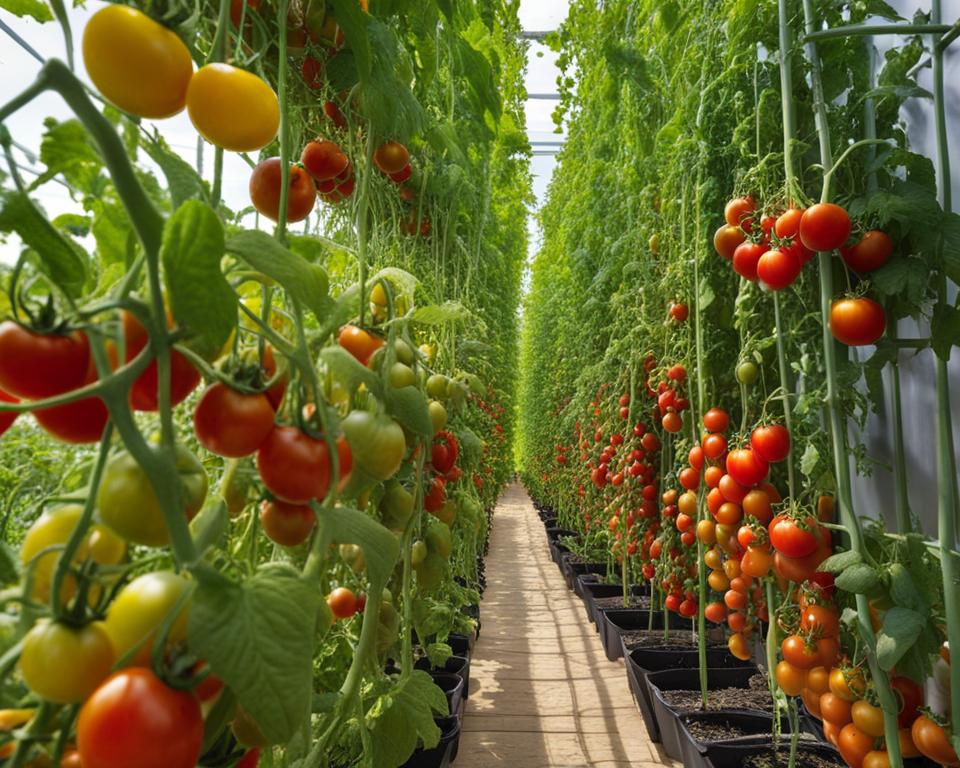
Tomato Varieties for Vertical Gardens
Here are some of the best tomato varieties for vertical gardening:
| Tomato Variety | Description | Best for |
|---|---|---|
| Patio | A compact variety that grows well in containers and small spaces. It produces a high yield of medium-sized fruit. | Small-space gardening and container gardening |
| Better Bush | A determinate variety that produces a high yield of medium to large-sized fruit. It’s disease-resistant and is perfect for vertical gardens. | Vertical gardening and small-space gardening |
| Sweet 100 | A cherry tomato variety that produces a high yield of small, sweet fruit. It’s disease-resistant and grows well in containers and hanging baskets. | Vertical gardening, container gardening, and hanging baskets |
| Sun Gold | A cherry tomato variety that produces a high yield of sweet, tangy fruit. It’s disease-resistant and grows well in containers. | Vertical gardening and container gardening |
Remember, selecting the right tomato varieties is just one piece of the puzzle. With proper care, pruning, and training techniques, you can maximize your harvest and enjoy a bountiful yield of delicious tomatoes from your vertical garden.
Planting and Caring for Vertical Tomato Gardens
Planting and caring for tomatoes in vertical gardening systems requires a bit of planning and attention to detail. Here are some vertical tomato growing tips that will help you nurture healthy plants and enjoy a bountiful harvest:
- Choose the right soil: Using nutrient-rich soil is crucial for plant growth. Choose a high-quality potting mix that retains moisture and is well-draining.
- Start with healthy seedlings: Select healthy seedlings that are free from pests and diseases. Make sure they are well-suited for vertical gardening systems.
- Optimize moisture levels: Moisture is essential for plant growth, but overwatering can lead to root rot. Monitor moisture levels regularly and adjust watering as necessary. Consider using a self-watering system to maintain even moisture levels.
- Provide adequate support: Tomato plants in vertical gardening systems require support to grow upright. Use a tomato trellis system or tomato cage to provide support and prevent the plant from toppling over.
- Fertilize regularly: Tomatoes require regular fertilization to thrive. Use a balanced fertilizer every two weeks to provide essential nutrients. Consider using a vertical hydroponic tomato system to provide optimal nutrition to your plants.
- Prune and train your plants: Pruning and training tomato plants are essential for preventing disease and encouraging robust growth. Remove any suckers that sprout from the base of the plants and train the main stems to grow up the trellis or cage.
By following these tips, you can ensure the success of your vertical tomato garden. However, keep in mind that every plant is different, and adjustments may need to be made along the way. Paying attention to your plants and making necessary changes will lead to a bountiful harvest of delicious tomatoes!
Nutrient Management in Vertical Tomato Gardens
As vertical gardens have limited space, it’s essential to ensure that your tomato plants receive the necessary nutrients for optimal growth and development. Proper nutrient management is crucial for the success of your vertical tomato garden.
There are various ways to manage nutrients in vertical tomato gardens, including:
| Method | Description |
|---|---|
| Soil-based | In a soil-based system, you’ll need to amend your soil with organic matter like compost or fertilizer to provide the necessary nutrients for your tomatoes. |
| Hydroponic | In a hydroponic system, you can use nutrient-rich water to feed your tomatoes. This method gives you more control over the nutrients your plants receive and can result in higher yields. |
| Aeroponic | An aeroponic system uses a mist to deliver nutrients to your tomato plants. This method is highly efficient and can result in faster growth and higher yields. |
If you’re using a hydroponic or aeroponic system for your vertical tomato garden, you’ll need to monitor the nutrient levels regularly and adjust them as necessary.
It’s important to note that over-fertilizing can be harmful to your tomato plants and may lead to poor growth or even death. Follow the manufacturer’s instructions carefully and avoid using too much fertilizer.
With the right nutrient management, you can ensure healthy and robust tomato plants in your vertical garden.
Pruning and Training Tomato Plants in Vertical Gardens
Pruning and training tomato plants in vertical gardens are essential techniques that can help maximize productivity and prevent disease. Proper pruning and training can also help your tomato plants stay healthy and strong, producing plenty of delicious tomatoes.
Here are some vertical tomato growing tips for pruning and training:
- Start early: When your tomato seedlings reach about 6 inches tall, it’s time to start pruning. Remove the bottom set of leaves and any suckers that may grow in the crotch between stems.
- Use a tomato cage: To keep your tomato plants upright, consider using a tomato cage. As your plants grow, gently guide the stems through the cage and secure with twine if needed. This will help keep your tomato plants stable and reduce the risk of breakage.
- Pinch back: Pinch back the growing tips of your tomato plants when they reach the top of your trellis or support system. This will encourage the plant to focus on growing fruit instead of foliage.
- Remove suckers: Suckers are small shoots that develop in the crotch between the main stem and a branch. While they can produce fruit, they can also take away vital nutrients from the main plant. Remove them regularly to redirect the energy to the main stem and fruit-bearing branches.
- Loosely tie: As your tomato plants grow, loosely tie them to the support system to keep them upright and prevent breakage. Use soft, flexible ties and avoid tying too tightly, as this can damage the stem or restrict growth.
Pruning and training tomato plants in vertical gardens can seem intimidating at first, but with these tips, you’ll be well on your way to a healthy and productive tomato harvest.
Dealing with Pests and Diseases in Vertical Tomato Gardens
When it comes to vertical gardening systems for tomatoes, pests and diseases are common challenges that can arise. However, with proper prevention and treatment techniques, you can keep your tomato plants healthy and thriving.
Prevention: The best way to deal with pests and diseases is to prevent them from occurring in the first place. Make sure to maintain good hygiene in your vertical garden by removing any dead or decaying plant material or debris. This will help to prevent the buildup of harmful fungi and bacteria. Additionally, keep your tomato plants well-watered and fertilized to ensure they are healthy and strong, as strong plants are more resistant to pests and diseases.
Treatment: If you do notice pests or signs of disease in your vertical tomato garden, it’s important to take action immediately. Depending on the issue, there are a variety of treatment options available.
| Pest/Disease | Treatment |
|---|---|
| Aphids | Introduce natural predators such as ladybugs or use a neem oil spray |
| Spider mites | Introduce natural predators such as predatory mites or use a horticultural oil spray |
| Tomato blight | Remove affected plant parts and use a copper fungicide spray |
| Blossom end rot | Ensure consistent watering and calcium supplementation |
Remember to always follow the instructions carefully when using any treatment method, and consider using natural and organic options if possible.
By taking preventative measures and treating any issues that arise promptly, you can successfully overcome pests and diseases in your vertical tomato garden.
Harvesting and Enjoying Your Vertical Tomato Bounty
After months of nurturing your tomato plants, it’s finally time to reap the rewards of your hard work. Harvesting your homegrown tomatoes is incredibly rewarding, and with vertical gardening systems for tomatoes, you can do it without taking up valuable space in your garden. Here are some tips for harvesting and enjoying your vertical tomato bounty:
- Harvest your tomatoes when they are fully ripe and have reached their optimal color. For most varieties, this will be when they are bright red.
- Gently twist or clip the stem near the base of the fruit to remove it from the plant.
- Handle your tomatoes carefully to avoid bruising or damaging them.
Now that you have harvested your ripe tomatoes, it’s time to enjoy them! Here are some delicious ways to savor your vertical garden’s bountiful harvest:
- Slice up your tomatoes and use them in a fresh Caprese salad with mozzarella cheese, basil, and a drizzle of balsamic vinegar.
- Roast your tomatoes with garlic and olive oil for a flavorful side dish or topping for bruschetta.
- Make a classic tomato sauce to use in pasta dishes or spread on pizza.
- Crisp up some bacon, lettuce, and toast, and stack your fresh tomatoes for a classic BLT sandwich.
With these simple tips, you can enjoy the fruits of your labor and savor the delicious taste of homegrown tomatoes from your vertical garden. Don’t forget to share your tasty harvest with family and friends!
Conclusion
As someone who loves gardening, I can say that vertical gardening systems for tomatoes are an exciting way to elevate your gardening game. By following the techniques and systems I’ve outlined in this article, you can grow delicious tomatoes right at home and maximize your space.
Taking Your First Steps
If you’re new to vertical gardening, it may seem daunting at first. But don’t worry, with a little bit of planning and research, you can create an amazing tomato garden that you can be proud of. Take the time to choose the right vertical gardening system that suits your needs, prepare your space, and select the best tomato varieties for vertical growth.
Caring for Your Tomatoes
Once your tomato plants are growing, give them the care they need to thrive. This includes monitoring moisture levels, managing pests and diseases, and providing the necessary nutrients for robust growth. Also, remember to prune and train your tomato plants to promote healthy growth and abundant harvests.
Harvesting Your Bounty
Finally, the moment you’ve been waiting for. When your tomatoes are ripe and ready, it’s time to harvest and enjoy them. Whether you prefer eating them fresh or cooking them in a dish, your home-grown tomatoes will be bursting with flavor.
So what are you waiting for? Start your vertical gardening journey today and discover the joys of growing tasty tomatoes right at home.
FAQ
How can vertical gardening benefit tomato growth?
Vertical gardening maximizes space, provides support with tomato trellis systems, and offers creative vertical tomato garden ideas.
What vertical gardening system should I choose for tomatoes?
Consider tomato planters designed for vertical gardening or explore innovative hydroponic systems.
What are some basic tips for successful vertical tomato gardening?
Understand the key elements of vertical tomato gardening and follow expert tips for optimal growth.
How do I prepare my vertical garden for tomatoes?
Set up your vertical gardening system, choose a suitable tomato tower, and optimize your space for optimum growth.
Which tomato varieties are best for vertical gardening?
Explore tomato varieties that thrive in vertical systems and learn how to choose the right ones for a bountiful harvest.
What techniques should I use to plant and care for tomatoes in vertical gardens?
Follow proper techniques from seedling selection to maintaining moisture levels for healthy tomato plants.
How can I manage nutrient levels in my vertical tomato garden?
Learn about different techniques, including hydroponic systems, to ensure your tomatoes receive essential nutrients.
What pruning and training techniques are recommended for vertical tomato gardens?
Discover the best practices for maximizing productivity and preventing disease in your vertical tomato plants.
How can I deal with pests and diseases in my vertical tomato garden?
Learn how to identify common issues, implement preventative measures, and treat pests or diseases that may affect your tomato plants.
How do I harvest and enjoy tomatoes from my vertical garden?
Follow best practices for harvesting ripe tomatoes and savor the delicious fruits of your labor.
What is the conclusion of mastering vertical gardening systems for tomatoes?
Congratulations on mastering vertical gardening systems for tomatoes! Start your journey today and elevate your tomato-growing experience.

